THE GUINNESS TRUST HOLIDAY HOME (a.k.a. DENTON HOUSE) 1938 - 1996.
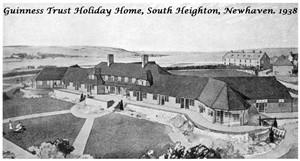
As planned by John L Denman
© The Guinness Trust
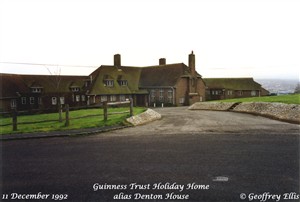
The GTHH entrance pre-1996
© Geoffrey Ellis
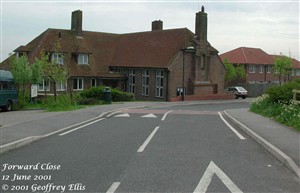
The above view post-1996, now Forward Close
© Geoffrey Ellis
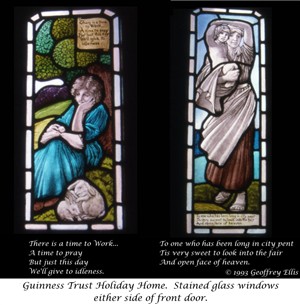
Stained glass windows with captions at main door
© Geoffrey Ellis
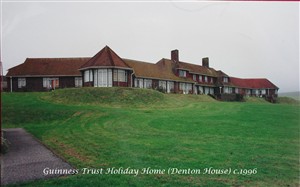
Southwest face of GTHH illustrating the pleasing symmetrical lines of the building.
© Geoffrey Ellis
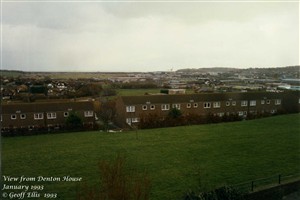
View south from GTHH in 1993. Before 1950 it was just lush green pasture all the way to Seaford Bay.
© Geoffrey Ellis
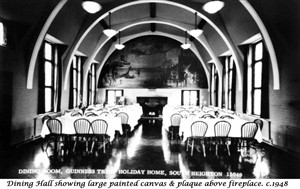
GTHH Dining Hall showing WWII painting of Newhaven Harbour
© The Guinness Trust
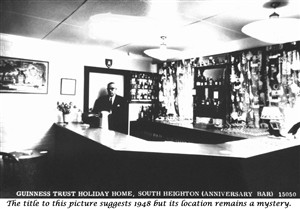
GTHH Anniversary Bar (1948?)
© The Guinness Trust
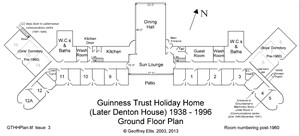
Post-1960 Ground Floor Plan showing WWII additions
© Geoffrey Ellis
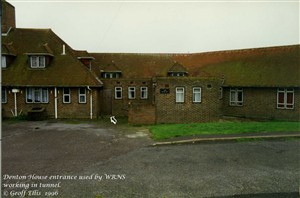
Entrance used by WRNS in WWII to enter the tunnel
© Geoffrey Ellis
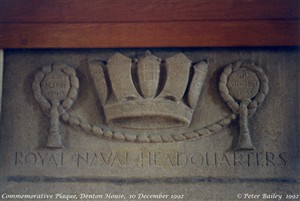
HMS Forward Commemorative Plaque in Hall. Unfortunately its brevity belies its true importance.
© Peter Bailey
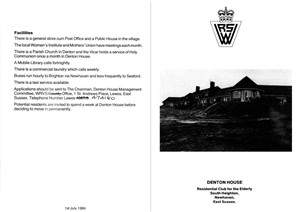
WRVS Pamphlet 1984 (Outer)
© Geoffrey Ellis
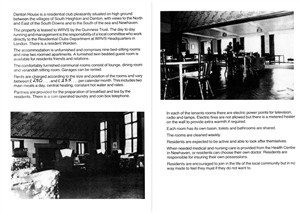
WRVS Pamphlet 1984 (Inner)
© Geoffrey Ellis
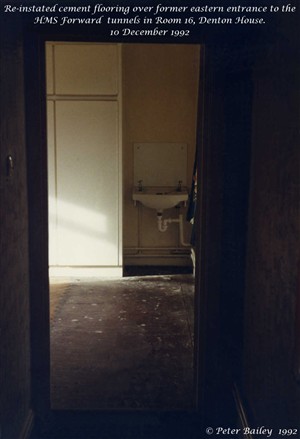
Re-instated floor in Room 16 that held a secret. People have used that basin for 45 years without knowing.
© Peter Bailey
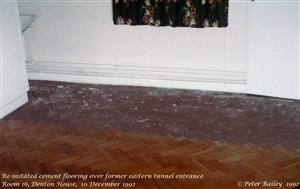
Room 16 floor as re-instated in 1945. This covered up part of the stairway down into the tunnel.
© Peter Bailey
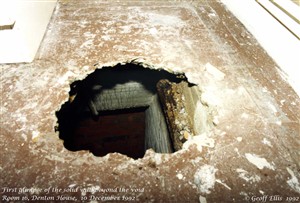
It was like re-opening Tutankhamen's Tomb... The camera does not lie. That floor was only 1 inch thick!
© Geoffrey Ellis
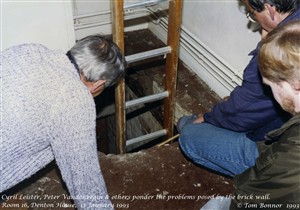
Getting through that wall won't be so easy!
© Tom Bonnor
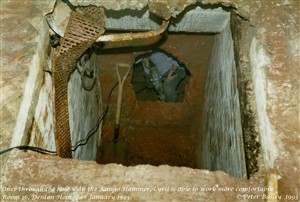
After three hard days 'nibbling away' at the wall with a Kango Hammer
© Peter Bailey
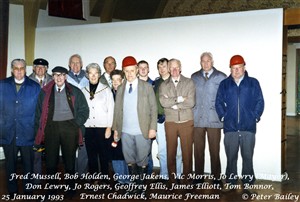
Local dignitaries & others visit the tunnel 25 January 1993
© Peter Bailey
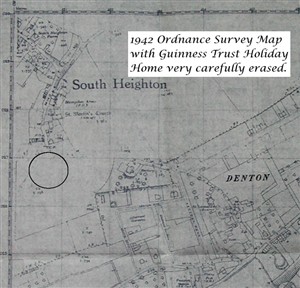
Wartime Ordnance Survey Map with GTHH officially erased for the duration
© Geoffrey Ellis
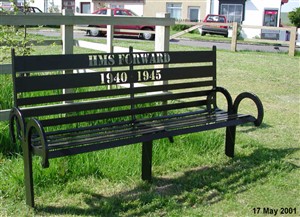
Seat, fashioned and forged at his farm, donated by Farmer Roger Brickell on his retirement from the village
© Geoffrey Ellis
The varied life and changing times of a much-loved building.
By Geoffrey Ellis
The Guinness Trust Holiday Home at South Heighton was designed by architect John L Denman and built by the Ringmer Building Works in 1938 to provide inexpensive holiday accommodation for “working class families” from the Trust’s London estates. It contained 16 double bedrooms and dormitories for boys and girls with communal dining, recreational and ablutions facilities, and a large south-facing sun lounge on the ground floor. There was a resident caretaker’s flat and staff accommodation on the upper floor. Two exquisite stained glass windows flank the front door; these are best viewed from within. An article in the East Sussex News records the formal opening of the Guinness Trust Holiday Home by Lord Amulree, G.B.E. on Friday 12 May 1939.
When the Second World War with Germany was declared in September 1939 the MOD quickly requisitioned the brand-new Guinness Trust Holiday Home to provide accommodation for the FANY (First Aid Nursing Yeomanry) who drove ambulances and staff cars in support of the British casualties and fatalities returning from the theatre of war on the French/German front.
In May 1940, the fall of Dunkirk and subsequent Nazis occupation of France prompted the Admiralty to evict the FANY from the Guinness Trust Holiday Home (There would be no further repatriation of front-line casualties now that France was occupied) and then re-requisition it as a Royal Naval Headquarters for the Newhaven sub-command from 20 June 1940.
Under the sterner title of HMS Forward, naval terminology applied throughout. The dining room became the Officers’ Ward Room, the toilets became 'heads', and the motor buses that ferried the 'crew' on and off duty were known as 'liberty boats'; to miss one or be late for duty incurred the punishable offence of 'being adrift'. (In Navy-speak the Home was a 'concrete frigate'). Outside, the GTHH grounds were surrounded with stacked barbed wire, and a machine-gun emplacement was sited by the front gate where it had a field of fire both up and down Heighton Road.
The GTHH lacked suitably-protected in-house accommodation for a Comms Room (telephone switchboard room), so the externally-accessed grounds man’s store beneath rooms 4 and 5 was reinforced and made fit for purpose. (This was later superseded in late 1941 by a purpose-built Comms centre in the tunnel). The store was clearly forgotten after the war because in 1945 when the Ministry of Works came to remove all evidence of military occupation they failed to recover the many steel girders and pit props installed in the store in 1940, and these remained in situ until 1996. See http://www.secret-tunnels.co.uk/ for further details and illustrations.
In March 1941, their Lordships at the Admiralty decreed that there should be a Royal Naval Plot at Newhaven to monitor all vessels using the English Channel between Hastings and Bognor Regis in conjunction with similar plots at Dover, Portsmouth and elsewhere on the South Coast. There was no adequately protected accommodation in the GTHH to house such a large and vital installation, and the decision was taken to excavate a deep underground system of tunnels.
The main entrance to the tunnel was situated in the Girls’ Dormitory (later to become Room 16 post 1960) in the extreme western wing of the GTHH from where 122 steps in 3 flights led down to the Operational Area. See the above web site for more information regarding the underground RN headquarters.
Following the cessation of hostilities, all the dominant equipment was removed from the tunnel, and the access to the tunnel from the Girls’ Dormitory was sealed off with a 13” solid brick wall (on the 21st November 1945 according to the bricklayer who did the job). The floor of dormitory was then concreted over and painted brown. And so it remained until 12 December 1992 when a group of Newhaven Historical Society members and I entered the GTHH, guided by Ernest (Chad) Chadwick (Lt. RN retired) who served as a Plotter in the GTHH during the war, looking for evidence of the former tunnel entrance. See http://www.secret-tunnels.co.uk/ for pictures of Chad.
During the war HMS Forward was secretly significantly involved in the maritime protection of the Sussex coast, its harbours, and the Merchant Navy, together with the Dieppe Raid, Air-Sea Rescue, the deployment and repatriation of Special Agents across the English Channel, the monitoring of the almost-nightly harassment of enemy shipping in enemy-controlled waters and harbours, the Invasion of Normandie, and the transport of materials and personnel during the liberation of France in 1944/5. As the headquarters of all Royal Naval establishments in Sussex, it also dealt with all personnel issues and equipment requisitions from torpedos to toilet rolls for every establishment and vessel in the command.
An undated Ordnance Survey Map (reckoned to be 1942 vintage) clearly shows every Nissen hut of the Army Transit Camp on Mount Pleasant, but the GTHH has been very carefully and convincingly ‘faded out’ so as not to be obvious. See illustration.
Between 1946 and 1990 the GTHH served some 16 years as a Guinness Trust Holiday Home, and 20-plus years as a WRVS Residential Club for the Elderly, renamed Denton House. ( I wish to thank Brenda McGhee (née Maynard) Feb 2012 (below) for revealing that the GTHH West Wing was originally the Girls’ Dormitory. This explains why only one set of double doors in this wing lead to the sun terrace – I have often wondered why. It also confirms that the conversion of this dormitory into three rooms 14, 15, & 16 preceded the WRVS occupation of the building in the 1960s. Correspondingly the Boys’ Dormitory in the GTHH East Wing became three rooms 6, 7, & 8).
During the war a gifted naval artist painted a scene of Newhaven Harbour c.1920 viewed from the bridge over the river on a large canvas that hung above the fireplace in the main hall. Sadly this was removed and destroyed during the redecoration of the GTHH for WRVS requirements. Today the only remaining evidence of it exists in backdrop of the many photographs of events that took place in the hall in the 1950s.
Evidence of WRVS occupation exists in the form of a 1984 four-page brochure stating that the accommodation provides for nine bed-sitting rooms and nine two-roomed apartments, with a furnished twin-bedded room available for residents friends and relations. Rents varied according to size and position of rooms, between £250 and £255 (in 1984) per calendar month. That included two main meals a day, central heating, constant hot water and rates. Pantries were provided for the preparation of breakfast and tea by the residents. In the late1980s a change in government funding caused the WRVS to withdraw, and the building then became tenantless.
A picture dated 25 January 1993 shows a group of local dignitaries and others assembled in the GTHH hall before making a preliminary tour of the then recently revealed tunnels.
In the Sussex Express of Friday 7th October 1994 the following notice was published on behalf of the Lewes District Council"LW/94/1310F Denton House, South Heighton. Demolition of existing bungalows and single storey wings to Denton House for the erection of 32 houses and the conversion of Denton House to provide six flats and community facilities with associated car parking and landscaping for Guinness Trust SE (Southern) Area".
The day of reckoning arrived in March 1996 when contractors arrived on site to start the part-demolition and reordering of the building that had stood majestically looking out over Seaford Bay and the lush green meadows of yesteryear that had also lost out in the name of progress and modernisation. It also marked the end of any further access to the tunnel via room 16.
On behalf of the Newhaven Historical Society I wish to acknowledge our gratitude to the Guinness Trust for granting us gratuitous access to the Holiday Home from January 1993 to March 1996 as required for historical research purposes. Without this access much evidence would have remained undiscovered, and the story of this building would have been less complete. Of particular note were the truncated in-situ remains of the Lamson message tube system and evidence of abandoned Army field telephone wires known as ‘Don-8’ running through the GTHH roof above rooms 10 - 16, and last but by no means least the extremely fortuitous discovery of the ‘Aladdin’s Cave’ of residual evidence in the grounds man’s store.
The Guinness Trust has kindly loaned three treasured artefacts to Newhaven Historical Society for exhibition in the Newhaven Local & Maritime Museum. They are the HMS Forward Ship’s Bell (‘borrowed’ from HMS Steady, that was mined and sunk off Newhaven in 1940); the HMS Forward Visitors book (that records the visits of many VIPs from as far afield as Canada and New Zealand, and one Lt Gen Bernard Law Montgomery on 26 November 1941); and an engraved copper plaque inscribed ‘This book containing 108 signatures of Distinguished Visitors to the Home during World War II, was left to the Guinness Trust, for preservation by Capt L S Brown, R.N., the Officer responsible for the Home throughout its occupation by the Royal Navy, on his death on 18th December 1948.’
Finally, Farmer Roger Brickell donated a fitting memorial to the village to commemorate the wartime contribution paid by the Guinness Trust Holiday Home during the darkest days of World War II upon his retirement from the village. His most appropriate gift, was the uniquely fashioned metal seat engraved ‘HMS FORWARD, 1940 – 1945’ that today stands on South Heighton Green, some 50 metres from the front door of the former Home. A further reminder is the aptly named ‘FORWARD CLOSE’ close by, so christened during the site developments of 1996.
© 2010, 2013 Geoffrey Ellis